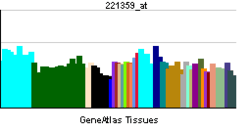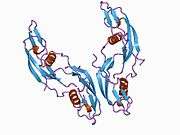Glial cell line-derived neurotrophic factor
| View/Edit Human | View/Edit Mouse |
Glial cell-derived neurotrophic factor (GDNF) is a protein that, in humans, is encoded by the GDNF gene.[3] GDNF is a small protein that potently promotes the survival of many types of neurons.[4] It signals through GFRα receptors, particularly GFRα1.
Function
This gene encodes a highly conserved neurotrophic factor. The recombinant form of this protein was shown to promote the survival and differentiation of dopaminergic neurons in culture, and was able to prevent apoptosis of motor neurons induced by axotomy. The encoded protein is processed to a mature secreted form that exists as a homodimer. The mature form of the protein is a ligand for the product of the RET (rearranged during transfection) protooncogene. In addition to the transcript encoding GDNF, two additional alternative transcripts encoding distinct proteins, referred to as astrocyte-derived trophic factors, have also been described. Mutations in this gene may be associated with Hirschsprung's disease.[4]
The most prominent feature of GDNF is its ability to support the survival of dopaminergic and motorneurons.
These neuronal populations die in the course of Parkinson's disease and amyotrophic lateral sclerosis (ALS). GDNF also regulates kidney development and spermatogenesis, and it affects alcohol consumption.[5]
GDNF family of ligands (GFL)
GDNF was discovered in 1991,[6] and is the first member of the GDNF family of ligands (GFL) found.
Interactions
Glial cell line-derived neurotrophic factor has been shown to interact with GFRA2[7][8] and GDNF family receptor alpha 1.[7][8]
Potential as therapeutics
GDNF has regenerative properties for brain cells and showed potential as treatment for Parkinson's disease - monkeys with an induced form of Parkinson's disease showed less trembling when treated with the drug, and neuronal fibres grew in part of the human brain exposed to the drug.[6] However progress to a treatment is hampered by the problem of delivering the drug to brain cells through the blood-brain barrier in human.[6]
Vitamin D potently induces GDNF expression.[9]
Exposure of dopaminergic-like cell line to Ibogaine HCl results in an increase in GDNF mRNA, leading to protein expression and to the corresponding activation of the GDNF signaling pathway.[10] This, in turn, leads to a further increase in the mRNA level of the growth factor through a feed-back loop.[10] It was also found that ibogaine metabolite, noribogaine, also possess the ability to increase GDNF levels.[11]
References
- ↑ "Human PubMed Reference:".
- ↑ "Mouse PubMed Reference:".
- ↑ Lin LF, Doherty DH, Lile JD, Bektesh S, Collins F (May 1993). "GDNF: a glial cell line-derived neurotrophic factor for midbrain dopaminergic neurons". Science. 260 (5111): 1130–2. doi:10.1126/science.8493557. PMID 8493557.
- 1 2 "Entrez Gene: GDNF glial cell derived neurotrophic factor".
- ↑ Carnicella S, Kharazia V, Jeanblanc J, Janak PH, Ron D (Jun 2008). "GDNF is a fast-acting potent inhibitor of alcohol consumption and relapse". Proceedings of the National Academy of Sciences of the United States of America. 105 (23): 8114–9. doi:10.1073/pnas.0711755105. PMC 2423415
 . PMID 18541917.
. PMID 18541917. - 1 2 3 Vastag B (Aug 2010). "Biotechnology: Crossing the barrier". Nature. 466 (7309): 916–8. doi:10.1038/466916a. PMID 20725015.
- 1 2 Jing S, Yu Y, Fang M, Hu Z, Holst PL, Boone T, Delaney J, Schultz H, Zhou R, Fox GM (Dec 1997). "GFRalpha-2 and GFRalpha-3 are two new receptors for ligands of the GDNF family". The Journal of Biological Chemistry. 272 (52): 33111–7. doi:10.1074/jbc.272.52.33111. PMID 9407096.
- 1 2 Cik M, Masure S, Lesage AS, Van Der Linden I, Van Gompel P, Pangalos MN, Gordon RD, Leysen JE (Sep 2000). "Binding of GDNF and neurturin to human GDNF family receptor alpha 1 and 2. Influence of cRET and cooperative interactions". The Journal of Biological Chemistry. 275 (36): 27505–12. doi:10.1074/jbc.M000306200. PMID 10829012.
- ↑ Eserian JK (July 2013). "Vitamin D as an effective treatment approach for drug abuse and addiction". Journal of Medical Hypotheses and Ideas. 7 (2): 35–39. doi:10.1016/j.jmhi.2013.02.001.
Vitamin D is a potent inducer of endogenous GDNF. The most prominent feature of GDNF is its ability to support the survival of dopaminergic neurons.
- 1 2 He DY, Ron D (2006). "Autoregulation of glial cell line-derived neurotrophic factor expression: implications for the long-lasting actions of the anti-addiction drug, Ibogaine". FASEB Journal. 20 (13): 2420–2. doi:10.1096/fj.06-6394fje. PMID 17023388.
- ↑ Carnicella S, He DY, Yowell QV, Glick SD, Ron D (2010). "Noribogaine, but not 18-MC, exhibits similar actions as ibogaine on GDNF expression and ethanol self-administration". Addiction Biology. 15 (4): 424–33. doi:10.1111/j.1369-1600.2010.00251.x. PMC 3783954
 . PMID 21040239.
. PMID 21040239.
Further reading
- Hofstra RM, Osinga J, Buys CH (1998). "Mutations in Hirschsprung disease: when does a mutation contribute to the phenotype". European Journal of Human Genetics. 5 (4): 180–5. PMID 9359036.
- Martucciello G, Ceccherini I, Lerone M, Jasonni V (Jul 2000). "Pathogenesis of Hirschsprung's disease". Journal of Pediatric Surgery. 35 (7): 1017–25. doi:10.1053/jpsu.2000.7763. PMID 10917288.
- Schindelhauer D, Schuffenhauer S, Gasser T, Steinkasserer A, Meitinger T (Aug 1995). "The gene coding for glial cell line derived neurotrophic factor (GDNF) maps to chromosome 5p12-p13.1". Genomics. 28 (3): 605–7. doi:10.1006/geno.1995.1202. PMID 7490108.
- Tomac A, Lindqvist E, Lin LF, Ogren SO, Young D, Hoffer BJ, Olson L (Jan 1995). "Protection and repair of the nigrostriatal dopaminergic system by GDNF in vivo". Nature. 373 (6512): 335–9. doi:10.1038/373335a0. PMID 7830766.
- Oppenheim RW, Houenou LJ, Johnson JE, Lin LF, Li L, Lo AC, Newsome AL, Prevette DM, Wang S (Jan 1995). "Developing motor neurons rescued from programmed and axotomy-induced cell death by GDNF". Nature. 373 (6512): 344–6. doi:10.1038/373344a0. PMID 7830769.
- Schaar DG, Sieber BA, Sherwood AC, Dean D, Mendoza G, Ramakrishnan L, Dreyfus CF, Black IB (Dec 1994). "Multiple astrocyte transcripts encode nigral trophic factors in rat and human". Experimental Neurology. 130 (2): 387–93. doi:10.1006/exnr.1994.1218. PMID 7867768.
- Lin LF, Doherty DH, Lile JD, Bektesh S, Collins F (May 1993). "GDNF: a glial cell line-derived neurotrophic factor for midbrain dopaminergic neurons". Science. 260 (5111): 1130–2. doi:10.1126/science.8493557. PMID 8493557.
- Bermingham N, Hillermann R, Gilmour F, Martin JE, Fisher EM (Dec 1995). "Human glial cell line-derived neurotrophic factor (GDNF) maps to chromosome 5". Human Genetics. 96 (6): 671–3. doi:10.1007/BF00210297. PMID 8522325.
- Gash DM, Zhang Z, Ovadia A, Cass WA, Yi A, Simmerman L, Russell D, Martin D, Lapchak PA, Collins F, Hoffer BJ, Gerhardt GA (Mar 1996). "Functional recovery in parkinsonian monkeys treated with GDNF". Nature. 380 (6571): 252–5. doi:10.1038/380252a0. PMID 8637574.
- Jing S, Wen D, Yu Y, Holst PL, Luo Y, Fang M, Tamir R, Antonio L, Hu Z, Cupples R, Louis JC, Hu S, Altrock BW, Fox GM (Jun 1996). "GDNF-induced activation of the ret protein tyrosine kinase is mediated by GDNFR-alpha, a novel receptor for GDNF". Cell. 85 (7): 1113–24. doi:10.1016/S0092-8674(00)81311-2. PMID 8674117.
- Angrist M, Bolk S, Halushka M, Lapchak PA, Chakravarti A (Nov 1996). "Germline mutations in glial cell line-derived neurotrophic factor (GDNF) and RET in a Hirschsprung disease patient". Nature Genetics. 14 (3): 341–4. doi:10.1038/ng1196-341. PMID 8896568.
- Salomon R, Attié T, Pelet A, Bidaud C, Eng C, Amiel J, Sarnacki S, Goulet O, Ricour C, Nihoul-Fékété C, Munnich A, Lyonnet S (Nov 1996). "Germline mutations of the RET ligand GDNF are not sufficient to cause Hirschsprung disease". Nature Genetics. 14 (3): 345–7. doi:10.1038/ng1196-345. PMID 8896569.
- Ivanchuk SM, Myers SM, Eng C, Mulligan LM (Dec 1996). "De novo mutation of GDNF, ligand for the RET/GDNFR-alpha receptor complex, in Hirschsprung disease". Human Molecular Genetics. 5 (12): 2023–6. doi:10.1093/hmg/5.12.2023. PMID 8968758.
- Haniu M, Hui J, Young Y, Le J, Katta V, Lee R, Shimamoto G, Rohde MF (Dec 1996). "Glial cell line-derived neurotrophic factor: selective reduction of the intermolecular disulfide linkage and characterization of its disulfide structure". Biochemistry. 35 (51): 16799–805. doi:10.1021/bi9605550. PMID 8988018.
- Bär KJ, Facer P, Williams NS, Tam PK, Anand P (Apr 1997). "Glial-derived neurotrophic factor in human adult and fetal intestine and in Hirschsprung's disease". Gastroenterology. 112 (4): 1381–5. doi:10.1016/S0016-5085(97)70154-9. PMID 9098026.
- Jing S, Yu Y, Fang M, Hu Z, Holst PL, Boone T, Delaney J, Schultz H, Zhou R, Fox GM (Dec 1997). "GFRalpha-2 and GFRalpha-3 are two new receptors for ligands of the GDNF family". The Journal of Biological Chemistry. 272 (52): 33111–7. doi:10.1074/jbc.272.52.33111. PMID 9407096.
- Eng C, Myers SM, Kogon MD, Sanicola M, Hession C, Cate RL, Mulligan LM (Feb 1998). "Genomic structure and chromosomal localization of the human GDNFR-alpha gene". Oncogene. 16 (5): 597–601. doi:10.1038/sj.onc.1201573. PMID 9482105.
- Amiel J, Salomon R, Attié T, Pelet A, Trang H, Mokhtari M, Gaultier C, Munnich A, Lyonnet S (Mar 1998). "Mutations of the RET-GDNF signaling pathway in Ondine's curse". American Journal of Human Genetics. 62 (3): 715–7. doi:10.1086/301759. PMC 1376953
 . PMID 9497256.
. PMID 9497256. - Yamaguchi Y, Wada T, Suzuki F, Takagi T, Hasegawa J, Handa H (Aug 1998). "Casein kinase II interacts with the bZIP domains of several transcription factors". Nucleic Acids Research. 26 (16): 3854–61. doi:10.1093/nar/26.16.3854. PMC 147779
 . PMID 9685505.
. PMID 9685505.
External links
- Glial Cell Line-Derived Neurotrophic Factor at the US National Library of Medicine Medical Subject Headings (MeSH)


